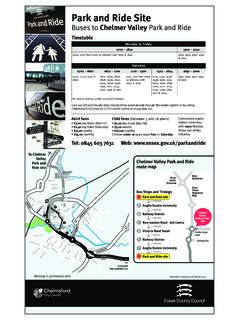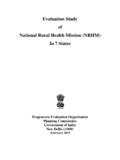Transcription of Local Bus Service Priority Policy 2015 to 2020
1 Local Bus Service Assessment and Priority Policy 2015 to 2020. Local Bus Service Priority Policy 2015 to 2020. Principles The role of the County Council as set out though the 1985, 2000 and 2008 Transport Acts is, in essence, to look at where market failure occurs in the Local road passenger transport network (that is where the needs of Local residents are not met by the commercial market), to determine whether in these instances a Service is needed and if, in the council's opinion, it is then to provide one. Given limited funding the Council therefore needs a way to decide how to balance the differing potential transport needs of residents when allocating funding (The Assessment Process).
2 It also needs to be able to manage the network in the light of changes to the commercial bus network, public demand and changing corporate priorities over time. This process needs to be objective and should be so constructed to as to contribute directly to the County Council's key outcomes. The key corporate outcomes are set out below: They are: Children in Essex get the best start in life. People in Essex enjoy good health and wellbeing. People have aspirations and achieve their ambitions through education, training and lifelong-learning. People in Essex live in safe communities and are protected from harm. Sustainable economic growth for Essex communities and businesses.
3 People in Essex experience a high quality and sustainable environment. People in Essex can live independently and exercise control over their lives. Transport outcomes that directly contribute to these corporate outcomes are set out below: 1. Providing access to schools, colleges, and training, work, health and leisure services . 2. Providing access to health services , shopping, leisure activities, employment, reducing isolation and increasing independence. 3. Providing access to learning and training opportunities, supplier workforce training and apprenticeships. 4. Providing access to care services and providing safe transport for access to health, education, work and leisure services , reducing the number of people killed or seriously injured (KSIs).
4 5. Attracting inward investment by offering improved connectivity, access to work and leisure opportunities and reducing congestion. 1. Local Bus Service Assessment and Priority Policy 2015 to 2020. 6. Reducing congestion, air quality and CO2 emissions. 7. Enabling access to key services , improving community involvement. The Local Bus Service Assessment and Priority System The Local Bus Service Assessment and Priority System has two Functions. First, given that it is not possible to fund every conceivable public transport need for Service users in Essex it will allow the Council to prioritise where its limited financial resources should be allocated as part of the area review process.
5 Second, once the revised supported bus network is put in place, it allows the Council to respond to changes to the commercial bus network over which it has no control and assess the need for additional contracted services that result from them (or indeed to cease providing a contracted Service where a comparable commercial Service is started. To this end the System comprises two processes, the Service Need Assessment Process and the Service Provision Priority Process. The Service Need Assessment System The Service Need Assessment System (SNAS) is aimed at determining whether there is a need for a Service as a result of commercial transport operators' failure to provide one.)
6 This comprises the following gateway' assessments that will help the County Council determine whether it needs to consider buying a supported Service in each circumstance. To proceed an assessment will need to pass all the gateways in order to progress: Assessment Stage 1: Is there market failure? The council will consider the following factors when determining whether a market failure has occurred. Are there reasonable alternative services on offer that will already allow residents to make the same Journey? Are there broadly comparable journeys or suitable alternative destinations accessible without the need for an intervention by ECC?
7 Will any ECC Service provision risk undermining the economic viability of a commercial Service ? If there are reasonable alternative or broadly comparable services available or of the provision of a contracted Service would undermine the economic viability of a commercial bus Service then normally assessment will end here and no contracted Service will be provided. 2. Local Bus Service Assessment and Priority Policy 2015 to 2020. If there are none, then the assessment proceeds to Assessment Stage 2. Definitions of what would be considered to be reasonable and broadly comparable in terms of services are set out in Appendix 1. Assessment Stage 2: Does the available transport for the area affected meet the Service Intervention Point (SIP) benchmark?
8 This stage considers whether in the absence of the Service or services in question, the areas affected still have a level of Service at or above that at which the County Council feels it is necessary to consider whether it is necessary to provide additional transport services . To this end the County Council has developing a series of tables setting out Service Intervention Points (SIPs) that indicate the level of bus Service available to residents in an area beneath which it will consider the need to provide additional transport services . The levels for urban and key interurban corridors are based on frequency along main transport corridors.
9 Those for peri-urban, suburban and rural areas will be based on population, with higher populations assumed to require better access to key services . The SIPs are intended based on the minimum Service levels set out the Essex Road Passenger Transport Strategy, adjusted to allow for changes to the commercial network since these were introduced, the need to reflect the Essex Outcomes and issues raised through the consultation and area review process. The proposed SIP tables are shown in Appendix 2 below. If the SIP level of Service is met by existing services , then assessment will normally stop here and no contracted Service will be provided.
10 If the SIP level is not met then assessment proceeds to Stage 3. Assessment Stage 3: What is the impact on current transport users? This stage assesses the impact of a loss of Service or decision to provide a Service on current or potential future bus Service users. 3. Local Bus Service Assessment and Priority Policy 2015 to 2020. This will be considered looking at: Are there any people using the Service toward whom the County Council has a statutory duty to provide transport? Are there key services or destinations that residents will not be able to access if a Service is not provided and are there no other destinations at which similar services can be obtained that can still be accessed by public transport?














